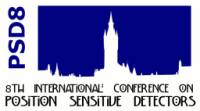Description
Poster Session 1 - Astrophysics, Space, Gaseous and Novel Photon detectors
Mr
Nestor Ferrando
02/09/2008, 15:10
Novel Photon Detection Systems
Poster
Indirect position detectors based on scintillator crystals don't have a spacial uniformity in their response. This happens due to crystal irregularities and gain differences between the photomultiplier anodes. In order to solve this, PESIC, an integrated front-end for multianode photomultiplier based nuclear imaging devices was created. One of its main features is the digitally programmable...
Mr
Hugo Natal da Luz
02/09/2008, 15:10
Gas Pixel Detectors
Poster
The Micro Hole & Strip Plate (MHSP) operating in a CF4 atmosphere aiming neutron imaging will be presented. Recent results of the MHSP operation in pure xenon have shown position resolutions of around 300 μm and gas gains well above 10^4 for tetrafluoromethane (CF4) at atmospheric pressure. CF4 combined with 3He is generally known as an efficient gas for proton and tritium stopping, produced...
Dr
Antonio Ranieri
(INFN Bari)
02/09/2008, 15:10
Novel Gas-based Detection Techniques
Poster
A mixed analog-digital ASIC prototype named GASTONE (GEM Amplifier Shaper Tracking ON Events) designed in the CMOS AMS 0.35um technology has been developed to specifically readout the cylindrical GEM inner tracking detector built as improvement of the KLOE apparatus at the e+e- DAFNE collider. The analog part of the ASIC is characterized by a very low power dissipation of 1.32 mW/channel for...
Dr
Goran Panjkovic
02/09/2008, 15:10
Novel Photon Detection Systems
Poster
The hybrid charge amplifiers have been around for some time and it seems they are approaching their technological maturity, but not the extinction yet. In this paper the design methodology is formalized and key design constraints are defined and discussed. Further, considering that components used in such preamplifiers are also reaching their technological maturity, it is possible to predict...
Laurence Carson
(Unknown)
02/09/2008, 15:10
Novel Photon Detection Systems
Poster
Pion/kaon discrimination in the LHCb experiment will be provided by two Ring Imaging Cherenkov (RICH) counters. These use arrays of 484 Hybrid Photon Detectors (HPDs) to detect the Cherenkov photons emitted by charged particles traversing the RICH. The HPD consists of a vacuum tube with a multi-alkali S20 photocathode deposited on the inside surface of a quartz entrance window, with the...
Dr
James Milnes
02/09/2008, 15:10
Novel Photon Detection Systems
Poster
The Image-Charge technique used with image tubes provides several operational and practical benefits by serving to isolate the electronic image readout from the detector. The simple dielectric interface between detector and readout provides vacuum isolation and no vacuum electrical feed-throughs are required. Since the readout is mechanically separate from the detector, an image tube of...
Mr
Craig Brown
02/09/2008, 15:10
Applications in Space Science
Poster
Improving the quantum efficiency (QE) and spectral resolution of X-ray sensitive charge-coupled devices (CCDs) for astronomy and planetary science applications is the primary focus of this work. These improvements are aimed at broadening the energy response of the detectors from 0.2 keV to >15 keV). Extending a the high energy response of a MOS (metal-oxide semiconductor) CCD can be achieved...
Mr
Xavier Francois Navick
02/09/2008, 15:10
Detectors for Astrophysics and Astro-Particle Physics
Poster
For events produced by betas, X and gammas rays underneath the surface of ionization and heat detectors, the collection of free charge carriers is poor. This is a strong limiting factor for Dark Matter research as WIMPs. For such events, electron recoils can indeed mimic nuclear recoils which generated by WIMPs. The solution is to localize of the interaction. This is the reason position...
Dr
Andrew Blue
(University of Glasgow)
02/09/2008, 15:10
Novel Photon Detection Systems
Poster
This work will report on the first work on the characterisation of a backthinned Vanilla - a 512x512 (25um squared) active pixel sensor. For some time, it has been predicted that the removal of the supporting substrate section of the sensor to allow detection via direct backside illumination would result in many potential benefits to applications in fields such as particle physics (lower mass)...
Mr
Yury Prokazov
02/09/2008, 15:10
Novel Photon Detection Systems
Poster
We describe position and time sensitive photon counting microchannel plate detector with improved quadrant anode readout system. The technique relies on a combination of the four planar elements pattern and an additional fifth electrode. The charge cloud induced by the event is split between the electrodes. The measured charge values uniquely define the position of the initial event. Quadrant...
Dr
Bo Kyung Cha
02/09/2008, 15:10
Novel Photon Detection Systems
Poster
We have manufactured thallium doped cesium iodide (CsI:Tl) scintillator thin films by the thermal deposition method. The scintillation characteristics of the CsI:Tl thin films was studied by the X-ray induced luminescence and photoluminescence(PL) for different Tl doping concentrations between 0.1~10.0mol%. The wavelength of the main emission peak was about 550nm for both studies, but the...
Dr
Alexadner Klyachko
02/09/2008, 15:10
Novel Gas-based Detection Techniques
Poster
The development and testing of a large area high count rate position-sensitive neutron detector based on Gas Electron Multiplier (GEM) is reported. With the use of 3He:CF4 gas mixture at atmospheric pressure, the detector is anticipated to have ~50% efficiency for cold neutrons, 5-10 mm spatial resolution, and to handle up to 10^6 cm-2s-1 count rates, sufficient for intended applications with...
Mr
David Hall
02/09/2008, 15:10
Novel Photon Detection Systems
Poster
The technology behind the Electron-Multiplying Charge Coupled Device (EMCCD) was successfully exploited by e2v technologies in the late 1990s. Since then, many uses have been found for these low light level (L3) devices including surveillance and many scientific applications. The EMCCD increases or "multiplies" the charge signal by the phenomenon of impact ionisation (or avalanche...
Mr
Neil Murray
02/09/2008, 15:10
Applications in Space Science
Poster
The CCD247 is the 2nd generation of high resistivity device to be manufactured in e2v technologies plc development programme. Intended for infrared astronomy, the latest devices are fabricated on high resistivity (~8 kΩcm) bulk silicon, allowing for a greater device thickness whilst maintaining full depletion when ‘thinned’ to a thickness of 150 μm. In the case of the front illuminated...

